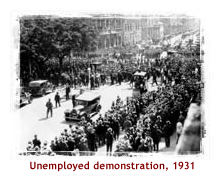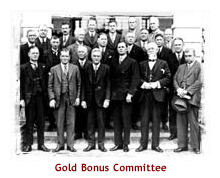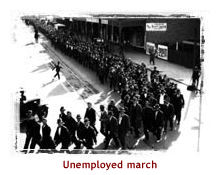Depression 1930s The world-wide economic downturn of the early 1930s resulted in severe unemployment and hardship throughout Western Australia. The loss of confidence in business, the drop in consumption and the huge fall in production resulted in record unemployment throughout Australia, with levels topping 30% in Western Australia.  Like most governments in Australia at the time, the State Government led
by Premier James Mitchell struggled to cope with the severe social, economic
and political problems caused by the Depression. Despite a bumper crop in
1931, wheat prices collapsed, leading to the militant Wheatgrowers' Union
attempting to strike in 1932 by withholding the delivery of crops and preventing
the forced sale of bankrupt properties through disrupting auctions. Like most governments in Australia at the time, the State Government led
by Premier James Mitchell struggled to cope with the severe social, economic
and political problems caused by the Depression. Despite a bumper crop in
1931, wheat prices collapsed, leading to the militant Wheatgrowers' Union
attempting to strike in 1932 by withholding the delivery of crops and preventing
the forced sale of bankrupt properties through disrupting auctions. In Perth unemployed men demonstrated in the streets, while those in work
saw their wages and conditions reduced. Hamstrung by the Premiers' Plan,
which sought to restore prosperity by reducing government spending and repaying
government debt, and unable to borrow money from London to pay for job creation
schemes, Mitchell's only remedy was to provide sustenance work for the unemployed
on public works schemes. While the Commonwealth Government did look to increased
gold production as one way of boosting the economy, governments throughout
Australia followed orthodox economic policy and reduced their spending.
In Perth unemployed men demonstrated in the streets, while those in work
saw their wages and conditions reduced. Hamstrung by the Premiers' Plan,
which sought to restore prosperity by reducing government spending and repaying
government debt, and unable to borrow money from London to pay for job creation
schemes, Mitchell's only remedy was to provide sustenance work for the unemployed
on public works schemes. While the Commonwealth Government did look to increased
gold production as one way of boosting the economy, governments throughout
Australia followed orthodox economic policy and reduced their spending.
|
Please note: The content on this website is made available for archival purposes and may not meet the State Library of Western Australia's current standards for web accessibility, mobile device compatibility, historical accuracy and cultural sensitivity.